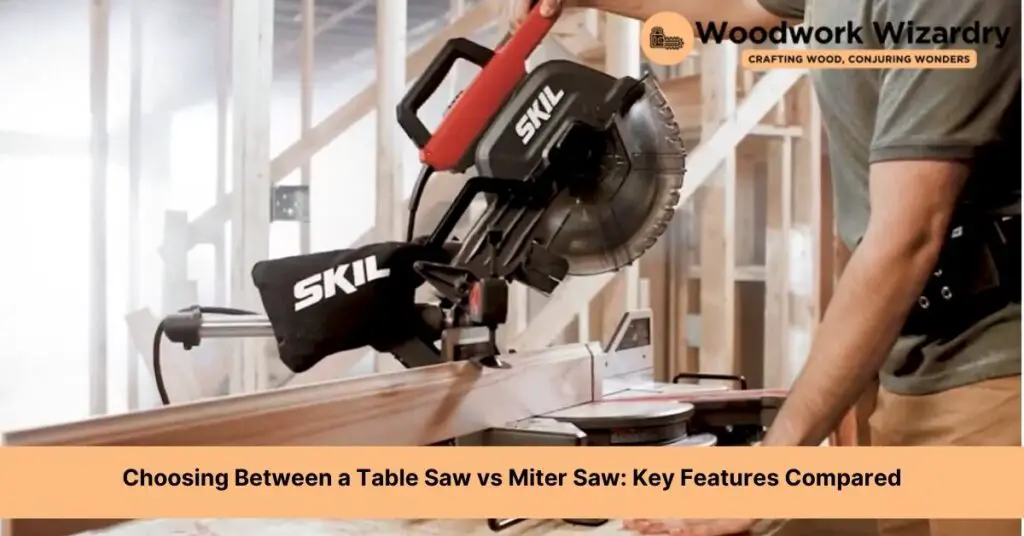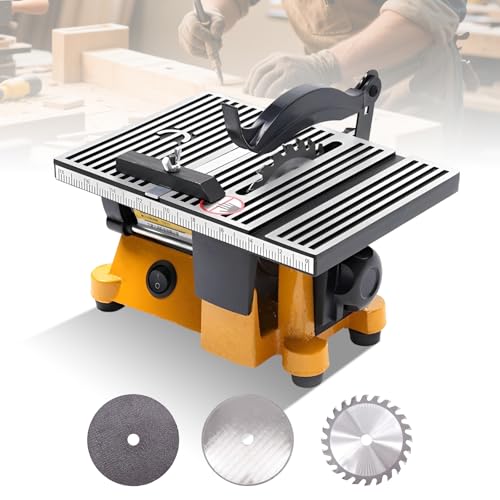When we dive into the world of woodworking, selecting the right tools can be as crucial as the skills we bring to the table. Among the myriad of choices, the table saw and miter saw stand out as fundamental tools for any woodworker. But when it comes to choosing between them, we often find ourselves at a crossroads. Each saw has its unique strengths and applications, making the decision not just a matter of preference but of understanding what each tool offers.
We’re here to explore the key differences between a table saw and a miter saw, shedding light on their functionalities, advantages, and when to use one over the other. Whether you’re setting up a new workshop or looking to upgrade your toolkit, understanding these differences is essential. Let’s embark on this journey together, ensuring you make the most informed decision for your woodworking projects.
Understanding the Basics
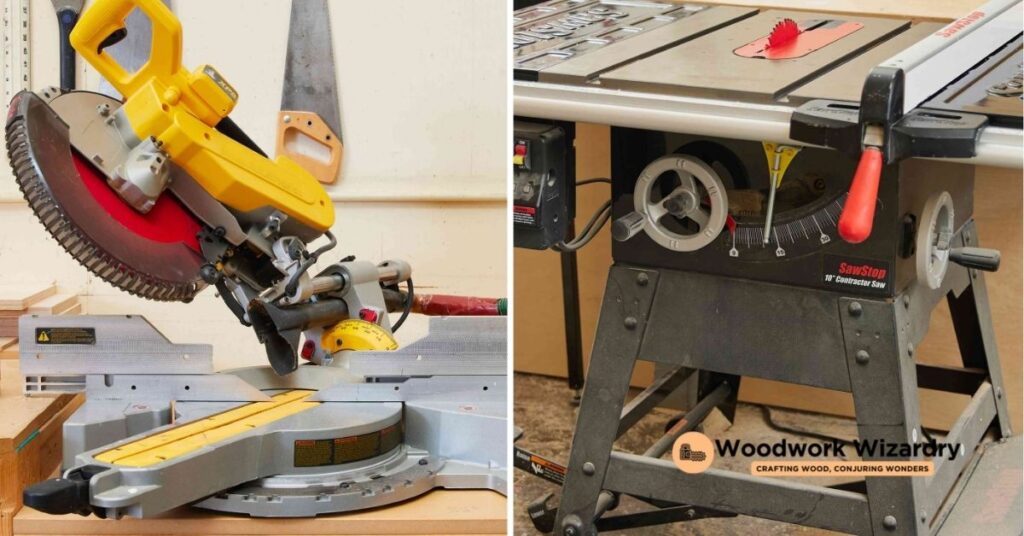
Diving into the world of woodworking tools, it’s essential for us to grasp the foundational aspects of both the table saw and the miter saw. Each saw serves a specific purpose and excels in different areas of woodworking, guiding us toward making precise cuts on wood with ease and efficiency.
Starting with the table saw, it’s a powerhouse for making straight cuts. Known for its versatility, a table saw consists of a circular blade mounted on an arbor and is powered by an electric motor. The blade protrudes through the top of a table, which provides support for the material being cut. It’s fantastic for long, straight cuts, ripping lumber, and even handling some joinery tasks. It’s the go-to tool for quick, straight cuts on boards of varying sizes, making it a staple in woodworking shops.
On the other hand, the miter saw specializes in making accurate crosscuts and miters. With a blade mounted on a swing arm that pivots left or right to produce angled cuts, it’s unmatched for precision in cutting angles. This saw is ideal for projects requiring tight fits, such as picture frames, door frames, and crown molding. It’s particularly valued for its ability to make repeated cuts at the same angle with pinpoint accuracy, a feature that’s indispensable for both complex projects and simple tasks requiring uniformity.
While both saws are crucial for woodworking, choosing between them depends on the project’s specific requirements. The versatility and efficiency of a table saw make it unparalleled for straight cuts and bulk work, while the miter saw’s precision for angled cuts positions it as the favorite for detailed and finishing work. Understanding these roles empowers us to select the right tool based on the task at hand, ensuring our projects’ success and the quality of our craftsmanship.
Key Features Comparison

Building on our understanding of the distinct roles table saws and miter saws play in woodworking, let’s dive into a detailed comparison of their key features. Knowing these differences helps us choose the right tool for each project, ensuring not just the success of our work but also enhancing the quality of our craftsmanship.
Blade Size
- Table saws typically come with larger blades, usually around 10 to 12 inches in diameter. This size enables them to handle a variety of tasks, including ripping through thick pieces of wood.
- Miter saws, on the other hand, feature smaller blades, generally between 8 to 12 inches. The size is optimal for making precise angled cuts.
Type of Cuts
- Table saws excel in making long, straight cuts along the grain of the wood, known as rip cuts. They’re also capable of crosscuts, albeit with less precision compared to miter saws.
- Miter saws specialize in crosscuts, angled cuts, and bevel cuts, offering exceptional accuracy. They’re the go-to for tasks requiring precise angle measurements.
Versatility
- Table saws are versatile, capable of performing a wide range of cuts by adjusting the blade height and angle. They can also accommodate accessories like jigs and dado blades for specialized tasks.
- Miter saws are less versatile in the variety of cuts they can make but offer unmatched precision for their specialized cuts, making them indispensable for certain projects.
- Table saws tend to be heavier and less portable, often becoming stationary fixtures in a workshop. However, there are portable table saw models designed for job site use.
- Miter saws are generally more portable and easier to move from one job site to another, making them ideal for contractors.
Understanding these key features helps us decide whether a table saw or a miter saw is the best fit for our specific woodworking needs, whether we’re aiming for versatility and broad utility or precision and specialized cutting.
Suitability for Projects
Continuing our exploration into the optimal tool selection for woodworking endeavors, let’s dive into the suitability of both table saws and miter saws for various project types. Our focus remains on helping woodworkers make informed decisions based on their project requirements.
Starting with table saws, we find their strong suit lies in their versatility and capacity to handle large volumes of work. Table saws excel in projects requiring long, straight cuts, such as ripping boards or cutting sheets of plywood. They’re indispensable for building furniture or cabinets, where accurate, straight cuts are paramount. Moreover, the table saw’s capability to accommodate a variety of blades and accessories allows for a broader range of applications, including dado cuts for joinery.
On the other hand, miter saws shine in projects that demand precision and detailed work, particularly where angled cuts are involved. Miter saws offer unparalleled accuracy for cutting frames, moldings, and trims, making them the tool of choice for finishing work and detailed carpentry. The ease of setting angles and making repetitive cuts ensures that projects requiring uniformity, such as picture frames or window casings, benefit significantly from a miter saw’s precision.
Moreover, for contractors or DIY enthusiasts who often work on-site, the portability of a miter saw can be a deciding factor. Its compact size and lighter weight make it easier to transport and set up in different locations, ensuring quality work is possible anywhere.
In sum, selecting between a table saw and a miter saw hinges on the nature of your projects. For extensive projects involving straight cuts or bulk material handling, table saws hold the edge. Conversely, for precise angled cuts and detailed work, miter saws are the go-to tool. Understanding the strengths and limitations of each saw ensures that woodworkers can choose the right tool to bring their visions to life with precision and efficiency.
Pros and Cons
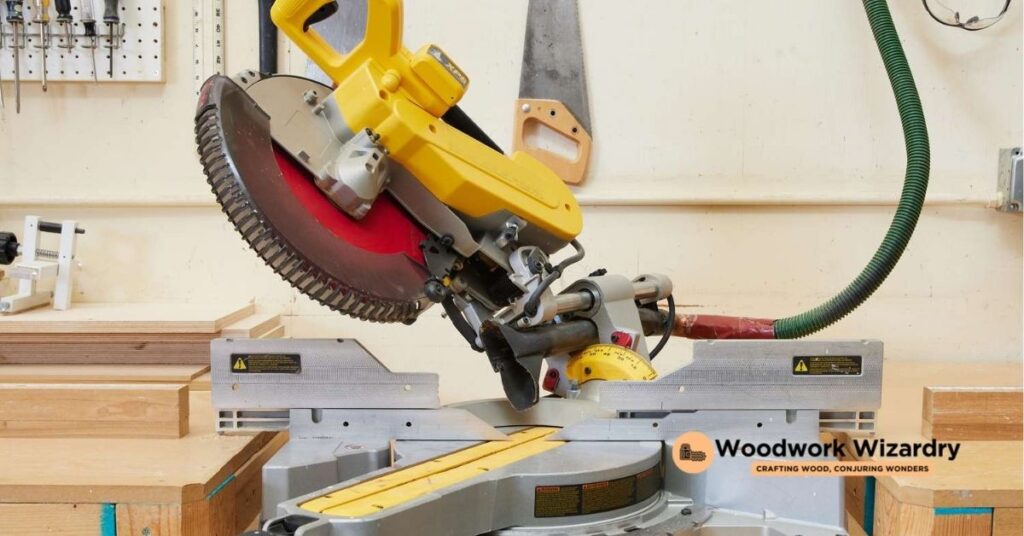
After laying out the key differences between table saws and miter saws, it’s essential to discuss their advantages and disadvantages to give a clearer picture of their applications in woodworking projects.
Table Saw Pros
- Versatility: Table saws are incredibly versatile tools. They can perform a wide range of cuts including straight, rip, and crosscuts.
- Power for Bulk Work: With their larger blades and more powerful motors, table saws excel at handling bulk materials and thick wood pieces.
- Long Cuts: Ideal for projects requiring long, straight cuts, table saws ensure accuracy and speed.
Table Saw Cons
- Size and Portability: Table saws are generally larger and not as easy to transport as miter saws, making them less convenient for on-site jobs.
- Safety Concerns: Due to their open blade design, there’s a higher risk of injury if not used with proper safety precautions.
Miter Saw Pros
- Precision in Angled Cuts: When it comes to making angled and beveled cuts, miter saws offer unparalleled precision and ease.
- Portability: Their compact size makes miter saws more portable and suitable for jobs requiring mobility.
- User-Friendly for Beginners: With features like preset angles, miter saws are more user-friendly, especially for woodworking beginners.
- Limited to Shorter Cuts: Miter saws can’t handle longer pieces of wood as efficiently as table saws due to their design constraints.
- Less Versatile: While excellent for precision cuts, miter saws are not as versatile as table saws and may require additional tools for various tasks.
Table saws stand out for their power and versatility, making them essential for large-scale projects and straight cuts, whereas miter saws excel in precision and ease of use, particularly for angled cuts and portability. Understanding these pros and cons helps us choose the right tool for our woodworking projects, ensuring efficiency and quality in our work.
Price Considerations
When it comes to outfitting a woodworking shop with either a table saw or miter saw, one of the crucial factors we look at is the price. Understanding the cost implications not just initially but also over the long term is vital in making an informed decision. Generally, table saws tend to be more expensive than miter saws when comparing models of similar quality. The starting price for a decent entry-level table saw can range from $150 to $500, whereas a good quality miter saw might start from $100 to $400. However, premium models of both saws can easily surpass $1000, depending on their features and specifications.
Yet, the purchase price isn’t the sole factor to consider. We also think about the cost of accessories, which can add up. Table saws often require additional accessories like dado blade sets, longer fences, and various jigs for different types of cuts, which can significantly increase the overall investment. On the other hand, miter saws might need stands, repeated blade replacements due to their specific use in precise cuts, and dust bags or collection systems, though generally at a lower total cost than table saw setups.
Another price consideration is longevity and maintenance costs. Table saws, with their robust construction and versatility, typically see a longer lifespan, potentially making them a more cost-effective choice in the long run. Miter saws, while also durable, may have slightly shorter lifespans due to their specialized nature of cuts, which can wear down the blade and motor more quickly.
When budgeting for a table saw or miter saw, it’s essential to consider not only the initial purchase price but also the cost of necessary accessories and potential long-term maintenance. These factors play a significant role in determining the overall value of the investment in a woodworking tool.
Making the Right Choice for Your Workshop
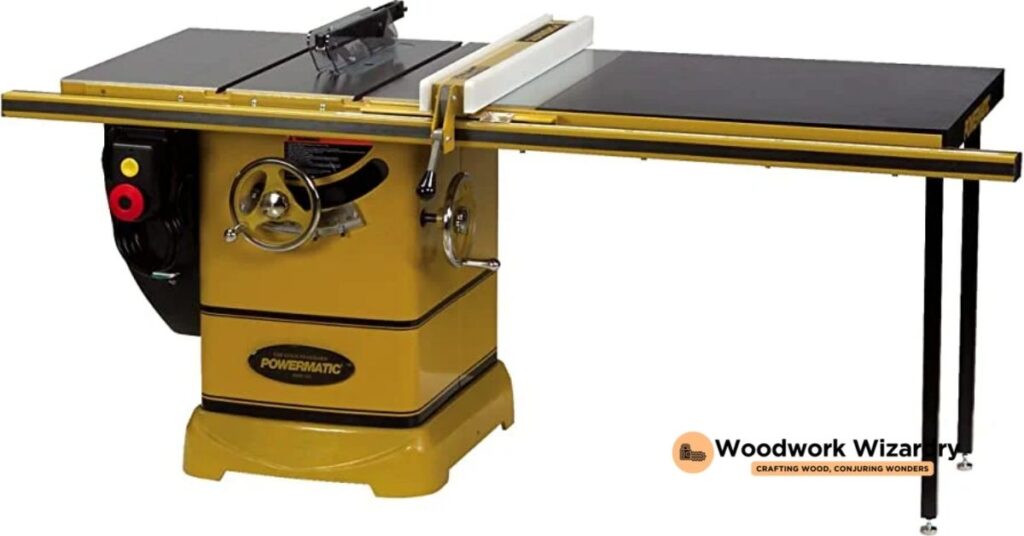
After exploring the distinctions, features, and project suitability of table saws and miter saws, we’ve laid a foundation to navigate the decision-making process for your workshop more effectively. Understanding both tools’ strengths and intended applications plays a pivotal role in determining which saw will best meet your needs.
For those of us managing diverse projects requiring a broad spectrum of cuts, a table saw offers remarkable versatility. Its capacity for handling everything from long, straight cuts to rabbets and dadoes with the right accessories makes it a powerhouse in the workshop. If your work leans more towards construction or furniture making, where precision in bulk cutting is crucial, a table saw proves invaluable.
Conversely, for projects demanding high precision in angled cuts—such as crown molding, picture frames, or any task where finish is everything—a miter saw stands out. The uncompromised accuracy and ease of use for making bevel, cross, and compound cuts make it indispensable for detailed work. This tool is particularly beneficial for carpenters and DIY enthusiasts whose projects involve intricate design elements.
Regarding portability, if your projects frequently take you on the road or require on-site adjustments, the miter saw offers unmatched convenience. Its lighter weight and compact design make it easy to transport, providing flexibility across various work environments.
Finally, when budget considerations come into play, it’s essential to weigh the initial cost against the long-term value. A table saw may require a higher initial investment but offers a wide range of applications, potentially saving money on the need for additional tools. Meanwhile, a miter saw, often more affordable upfront, specializes in precision cuts, which may suffice for your specific project demands without the need for extensive versatility.
Weighing these factors, we recommend assessing your most common project types, the variety of cuts needed, and how frequently you’ll use the tool in different locations. Aligning your workshop’s primary focus with the strengths of either a table saw or miter saw ensures you make a choice that enhances your woodworking efficiency and enjoyment.
Conclusion
We’ve walked through the ins and outs of both table saws and miter saws, highlighting what sets them apart and where they shine in a woodworking shop. It’s clear that the choice boils down to the specifics of your projects and what you value most in your workflow. Whether it’s the table saw’s versatility and capacity for bulk work or the miter saw’s precision for detailed cuts, both tools have their place in crafting beautiful pieces. Remember, assessing your most common projects and where you’ll use these tools will guide you toward the right addition to your workshop. Here’s to making informed choices that boost our woodworking efficiency and enjoyment!
Related Posts:
- Top Woods for Dremel Carving: Expert Picks & Tips
- Can Chainsaws Cut Through Bone? Debunking Myths and Facts
- Can You Dig a Trench with a Chainsaw? Safety & Efficiency Explored
- Staining Over Linseed Oil Finish: A Complete Guide
- How Long Does Wood Glue Take to Dry? Tips for Quick Drying
- Ultimate Guide: How to Stain Douglas Fir for Lasting Beauty
- Prevent Sap Leakage: Effective Wood Maintenance Tips
- Metabo C10RJS Review: Top Choice for Safety & Precision
- Choosing Between a Table Saw vs Miter Saw: Key Features Compared
- Top Picks for Best Plywood for Laser Cutting: Safety & Buying Guide
- Why Are Milwaukee Tools So Expensive? Unpacking the Premium Price
- Maximize Your Woodworking on a Budget: Tools, Tips, & Savings

